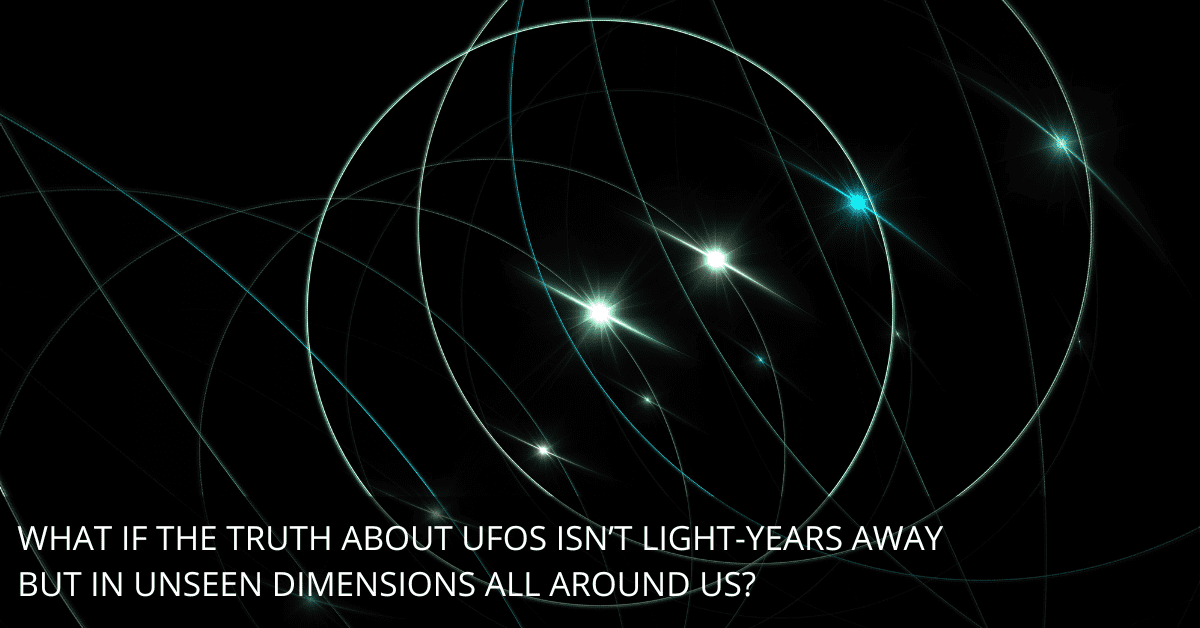
The Interdimensional Hypothesis presents a mind-bending idea in the field of ufology - that reported UFO sightings may not originate from distant planets but rather from alternate dimensions or parallel realities.
Imagine a multiverse, a collection of infinite alternate realities existing alongside our own, like the pages of an incomprehensibly thick book. Each of these "pages" or dimensions could follow its own unique set of physical laws, creating environments vastly different from our own. According to this hypothesis, UFOs may possess the ability to slip in and out of these alternate dimensions, appearing briefly in our reality before vanishing back into the unknown.
This interdimensional theory is not mere science fiction; it draws from cutting-edge developments in quantum mechanics. Concepts like the Many Worlds Interpretation and String Theory suggest that the existence of multiple, co-existing dimensions is not only scientifically plausible but perhaps even inevitable. While these higher dimensions may be beyond our current technological reach, their potential existence lends credence to the idea that UFOs could hail from radically different realms of reality - places we can scarcely begin to imagine. If true, the interdimensional hypothesis could profoundly reshape our understanding of the universe and humanity's place within it.
Quantum Mechanics and Multiple Dimensions
At the core of the Interdimensional Hypothesis is quantum mechanics. This branch of physics explains behavior at atomic and subatomic levels, where particles behave in ways that challenge traditional physics. Consider the double-slit experiment: it shows how particles (like photons) act differently when observed. Instead of behaving like solid particles, they act like waves, suggesting that reality might not be as straightforward as we think.
For example, imagine tossing a pebble into a pond. The ripples move outward, intersecting and creating patterns. In quantum mechanics, particles can exist as "waves of probability," overlapping with one another until they’re observed. This experiment fuels theories that multiple realities exist, each with its own unique interactions. It’s here that the Many Worlds Interpretation comes in, proposing that every possible outcome actually occurs—each in a separate reality. In this multiverse, it’s possible that a UFO could be crossing into our world from another dimension.
String Theory: Layers of Reality
String Theory, another key player in the Interdimensional Hypothesis, proposes that everything in our universe is made up of tiny, vibrating strings. But here’s the twist: String Theory doesn’t just account for the three spatial dimensions (length, width, and height) plus time; it suggests 11 dimensions. Think of them as hidden “rooms” within reality, each folding into one another in ways we can’t directly perceive.
If these dimensions exist, what does that mean for UFOs? Simple. These “strings” could theoretically vibrate in different dimensions simultaneously, allowing certain objects or entities to exist in multiple dimensions simultaneously. UFOs might operate on these levels, moving through spaces we can’t see. Under specific conditions, these entities might interact with our dimension, leading to those brief sightings before they disappear. Imagine UFOs as “visitors” who exist in parallel but invisible worlds, occasionally brushing up against our reality and creating the phenomena we experience.
How UFOs Could Manifest in Our Reality
The Interdimensional Hypothesis suggests that sightings could happen when certain physical or psychological conditions align. To picture this, think of tuning an old radio—adjusting the dial until you catch a faint signal from a distant station. Each dimension could be like a radio station, with UFOs appearing when the “frequency” of our reality aligns with theirs.
Changes in consciousness might also play a role. Accounts of UFO sightings often come from people in altered states—meditation, intense focus, or even deep distress. For example, a person in a heightened state might be more sensitive to these “overlaps” in dimensions, spotting a UFO where others wouldn’t. Or certain locations, known as “thin places,” might create conditions favorable for these crossings. The phenomenon could depend on environmental conditions, brainwave states, or unique locations that allow momentary overlap between realities.
What This Means for Our Understanding of UFOs
The implications of the Interdimensional Hypothesis are profound. If UFOs are interdimensional, it changes the game from trying to locate extraterrestrial civilizations light-years away to exploring the possibility of neighboring dimensions. Instead of physical travel across galaxies, we’re talking about travel across realms of existence. It reframes the UFO question from one of distance to one of dimensional boundaries.
If we accept the idea of dimensional travel, it might even explain why UFOs seem so “elusive”—flitting in and out of sight, displaying bizarre movements, and defying known laws of physics. It’s possible they’re not defying physics but simply following a different set of rules. Rather than thinking of UFOs as “aliens,” it might be more accurate to think of them as “inter-dimensionals.” They don’t need to build spacecraft to travel across dimensions; their natural state may already allow them to pass through multiple realities effortlessly.
Steps to Explore the Interdimensional Hypothesis
Want to explore this theory deeper? Here are a few steps you can take to get closer to understanding this fascinating hypothesis:
- Study Quantum Mechanics Basics: Start with foundational concepts like the double-slit experiment to understand why scientists believe multiple realities are possible. There’s no need to dive into equations—just focus on the implications of quantum behavior.
- Explore String Theory Fundamentals: Learn about String Theory’s multiple dimensions and how they might theoretically allow for interdimensional travel. Imagine each dimension as a unique “room” in a mansion, some of which we can’t access yet.
- Experiment with Mind States: Try meditation or other consciousness-altering practices to explore whether different mind states affect your perception of reality. People report that mindfulness and focus sometimes enhance awareness, potentially giving insight into dimensional overlaps.
- Research Thin Places: Some areas of the world are known as “thin places,” where the line between realms feels blurred. Visiting these areas might offer perspective on how unique environmental or physical conditions could influence dimensional experiences.
Bringing It All Together: Could We Be On the Brink of Discovery?
The Interdimensional Hypothesis invites us to think beyond the stars and consider that the mysteries we seek might lie right beside us in layers of existence we can’t yet touch. Imagine standing in a crowded city, each building buzzing with its own unseen life. You don’t see the entire population, but you know it’s there. Similarly, UFOs might simply be “neighbors” in a cosmic sense, living on adjacent pages of reality’s book.
To explore the unknown, we’ll need to shift our perception from looking outward to looking inward and sideways. While it’s a concept far from scientific consensus, the Interdimensional Hypothesis keeps the door open for those who dare to ask: What if we’re not alone—not in the universe, but in our own reality?

